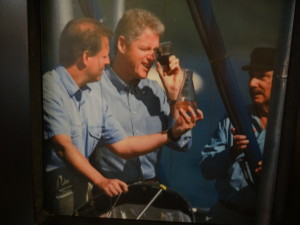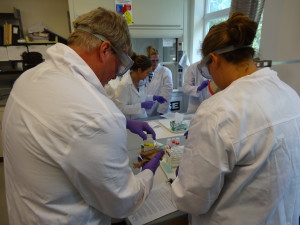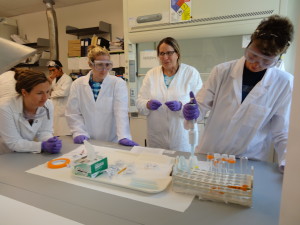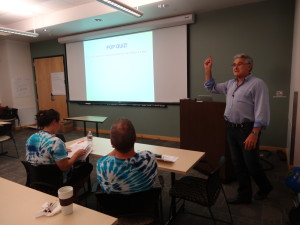We were teaching one of our Project Wet classes tonight when Lou Loftin shot this cool 30 second slow motion video of dropping water on a penny to demonstrate adhesion / cohesion. Enjoy!
Learning is messy!
We were teaching one of our Project Wet classes tonight when Lou Loftin shot this cool 30 second slow motion video of dropping water on a penny to demonstrate adhesion / cohesion. Enjoy!
Learning is messy!
3 weeks ago we participated in the Nevada Tahoe Teacher STEM Institute. Over 50 K – 9 teachers from all over Nevada came to the Tahoe Environmental Research Center (TERC) at Sierra Nevada College in Incline Village, Lake Tahoe, for a week of STEM learning. The funding was based on a Math/ Science Partnership Grant we wrote and received through the Nevada Department of Education. The event was put on by the Nevada’s Northwest Regional Professional Development Program, Washoe County School District, TERC, along with help and support from others mentioned in this post. BELOW: We started off with a group photo.
Sunday evening we started them off learning the science of tie-dye (covalent bonds and all) and made the case for STEM learning. We also set up a STEM notebook for each teacher as well as a digital notebook (blog).
The next day started at 6:30 am for breakfast and a day of Project WET, GEMS (Great Explorations in Math and Science), background in the Next Generation Science Standards (NGSS), a trip on the TERC research vessel on Lake Tahoe, stream studies and training on and set-up of blogs, wikis and a Flickr photo account – all of which we added to all week.
GEMS – Great Explorations in Math and Science
Out on the TERC research vessel
ABOVE: Field Lab Director Brant Allen explains the use of a Secchi disk in reporting out the clarity of the water in Lake Tahoe. The clarity has degraded from over 100 feet to about 70 feet since the 1960’s. BELOW: Secchi disk being lowered into the lake.
A couple of past visitors to the TERC research vessel you might recognize: 
BELOW: Stream monitoring and benthics.
During following days all teachers learned geology, aquatic habitats, space science, ocean science, food webs, the ethics of teaching outdoors – and the middle and high school teachers also worked in the Soluble Reactive Phosphorous Lab solving a mystery about pollution sources ala CSI. The grant provided experts from GEMS, TERC the USGS and others to teach classes and lead labs.

In the Soluble Reactive Phosphorous Lab
BELOW:Food webs
Ladybugs!
Participants loved the “Digital Sandbox”
 Geoff Schladow – Director of the Tahoe Environmental Research Center explains the “State of the Lake.”
Geoff Schladow – Director of the Tahoe Environmental Research Center explains the “State of the Lake.”
We also got to visit the lake at sunset:
Besides the more than 40 hours of training, participating teachers each received lessons, supplies and other resources to take back to their classrooms and students so they can use what they learned right away. In addition teachers will have monthly follow-up sessions to share their progress, ask questions, share resources they have developed and make connections through the classroom blogs, wikis and Flickr accounts they set-up. It was an intense and rewarding week of learning and sharing in one of the most beautiful locations on Earth!
Learning is messy!
One of the valuable STEM learning opportunities I’m part of right now is training teachers across our state in Project Wet. Think of it as Project Wet with a STEM focus.
We wrote and received a rather large grant sponsored by the Nevada Division of Environmental Protection (NDEP). Its enough money that we will be conducting these trainings for about 2 years with the goal of training hundreds of educators statewide in water and other science content.
Myself (I’m the STEM Learning Facilitator for northwest Nevada), Lou Loftin who is the Science Learning Facilitator, and Mary Kay Wagner an Environmental Scientist in the Bureau of Water Quality Planning with NDEP, are a team that travels around providing 16 hour trainings statewide. Nevada is a huge state (from here in Reno to Las Vegas is over 400 miles one way) so we put many miles on Lou’s truck which we cram full of equipment and supplies when we go on the road.
Currently we are in the middle of a 4 session class that convenes just south of here at River Fork Ranch in Genoa, Nevada.
We combine lessons right out of the Project Wet Guide 2.0 (which you cannot buy – you must participate in a least 6 hours of training in Project Wet to receive a guide) with hikes through the parks where our classes usually take place, some training in online photo archiving (Flickr), wikis and the online Project Wet Educator’s Portal.
Besides receiving a copy of the Project Wet guide, participants in our trainings also take supplies and resources provided by the grant back to their classrooms – beakers, pipettes, graduated cylinders, measuring tapes, Earth globes, maps and more. They also take back the links and online resources we help them register for (see above) and the network of teachers they meet and link to as part of the class. Several participating teachers have already brought their own students to the sites on field trips.
If you follow me on Twitter I often Tweet out photos and reports of where we are and what we’re up to. We have several more “Wet” classes coming up before June in eastern Nevada, and come fall we’ll continue our treks around the state. One of the “perks” of a project like this is getting to visit the beautiful places that abound in Nevada.
BELOW: Photos from our training in Las Vegas at the Clark County Wetlands where they pump 3 million gallons of water from the water treatment facility through the park daily to help provide habitat for a surprising amount of flora and fauna in the desert.
Learning is messy!